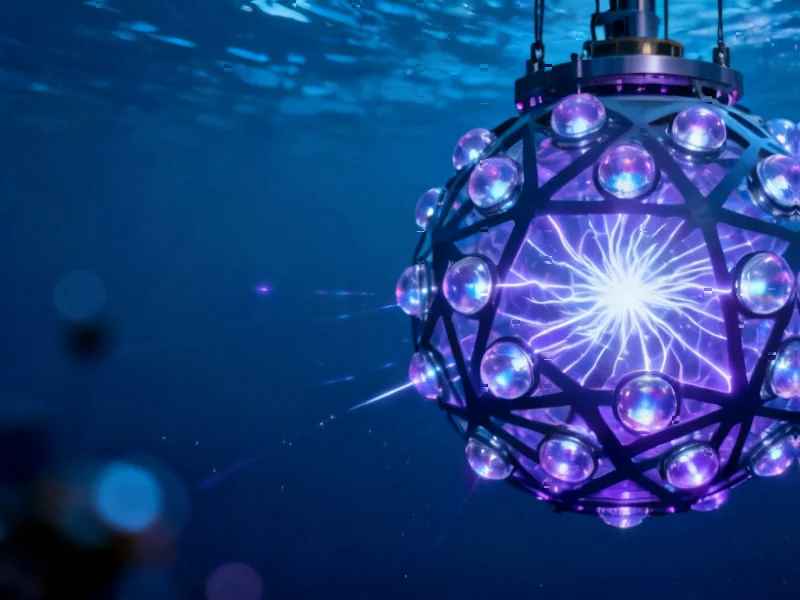Unprecedented Detection in Mediterranean Depths
Deep beneath the Mediterranean Sea, Europe’s ambitious KM3NeT telescope has captured what scientists are calling the most energetic neutrino ever detected. According to project reports, the subatomic particle registered an astonishing 220 petaelectronvolts—roughly 30 times more powerful than any neutrino previously recorded.
Table of Contents
The detection occurred in the early hours of February 13, 2023, when sensors arrayed across kilometer-long strings on the seafloor picked up an intense flash of pure energy. Researchers have been working to trace the particle’s origins ever since, with initial analysis suggesting it could rewrite our understanding of high-energy cosmic events.
Why Neutrinos Matter
Neutrinos represent one of physics’ most enduring mysteries. First theorized in the 1930s, these ghostly particles pass through ordinary matter almost completely unnoticed—billions stream through our bodies every second without interaction. Their lack of electric charge and minuscule mass make them exceptionally difficult to detect, yet their ability to travel across the universe unimpeded makes them perfect messengers from cosmic phenomena.
“Neutrinos are the closest thing to nothing we can imagine, but they are key to fully understanding the workings of the universe,” Paschal Coyle of the French National Centre for Scientific Research told project reporters. As neutrino research advances, scientists believe these particles could reveal secrets about everything from exploding stars to the fundamental nature of matter itself.
Engineering Marvel Meets Scientific Frontier
KM3NeT stands as one of Europe’s flagship research infrastructures, representing a massive international collaboration with EU and national funding. The project consists of two separate installations: ARCA off Sicily’s coast, designed to track high-energy neutrinos from deep space, and ORCA near Toulon, France, focusing on neutrino behavior and mass properties.
The telescope’s design is both elegant and ambitious. Basketball-sized glass spheres containing ultra-sensitive optical sensors are arranged in vertical lines stretching from the seafloor like underwater skyscrapers. More than 1,000 modules are already operational, with plans to expand to 6,000 by 2027.
“It seemed like a crazy idea to build a detector at the bottom of the sea to catch these very weird particles,” admitted Aart Heijboer, a senior physicist at the Dutch National Institute for Subatomic Physics who helped design the telescope infrastructure. “That caught my imagination.”
Solving Cosmic Mysteries
The record-breaking neutrino, designated KM3-230213A, has sparked intense speculation about its origins. Analysis suggests two primary possibilities: it could have emanated from a blazar—an active galaxy with a supermassive black hole hurling energy directly toward Earth—or it might represent a cosmogenic neutrino created when high-energy cosmic rays collide with photons.
Meanwhile, the ORCA installation focuses on how neutrinos oscillate between three different “flavors” as they travel through space. This research could reveal the ordering of neutrino masses, a crucial missing piece in the Standard Model of physics. Understanding these properties might finally explain why matter survived the Big Bang when matter and antimatter should have annihilated each other.
“All the experiments that try to measure the difference between a neutrino and an anti-neutrino get confused because they don’t know what the mass ordering is,” Coyle explained to project sources. “It’s an important input to figuring out why there’s more matter than antimatter.”
Europe’s Strategic Scientific Position
With this detection, Europe has firmly established its leadership in neutrino astronomy, complementing other major facilities like IceCube in Antarctica and Super-Kamiokande in Japan. The Mediterranean’s deep, clear waters provide ideal conditions for detecting the faint blue flashes of Cherenkov radiation that signal neutrino interactions.
As KM3NeT’s capabilities continue expanding with thousands more sensors planned, researchers anticipate more groundbreaking discoveries. The telescope represents not just a technological achievement but a fundamental reimagining of how we observe the universe’s most elusive phenomena.
For now, scientists continue analyzing the unprecedented detection, recognizing that each flash of light deep beneath the Mediterranean might carry messages about the birth of the cosmos—or even clues explaining why we exist at all.
Related Articles You May Find Interesting
- Gentle Squeeze Turns Atom-Thin Bismuth Into Metal, Enabling Rewritable Nanoelectronics
- MEmu Android Emulator 9.2.9 Boosts Performance with Key Compatibility Fixes
- AstraZeneca Opens Access to 500,000 Genomes Through New Research Platforms
- ESA Stages Carrington-Level Solar Storm Drill, Testing Satellite Survival Protocols
- Brain’s Hidden Nanotube Network Discovered, May Explain Alzheimer’s Spread



